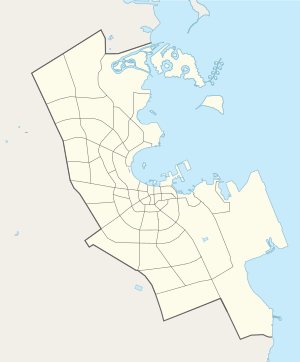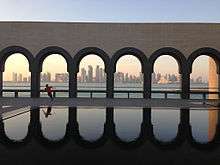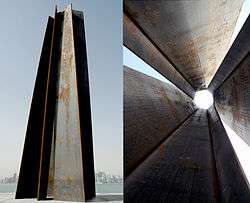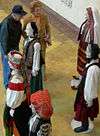Museum of Islamic Art, Doha
| متحف الفن الإسلامي | |
 | |
 Location within Doha | |
| Established | 22 November 2008 |
|---|---|
| Location | Doha, Qatar |
| Coordinates | 25°17′43″N 51°32′21″E / 25.29528°N 51.53917°ECoordinates: 25°17′43″N 51°32′21″E / 25.29528°N 51.53917°E |
| Type | Art Museum |
| Owner | Qatar Museums |
| Website |
www |
The Museum of Islamic Art (Arabic: متحف الفن الإسلامي, matḥaf al-fann al-islāmī) is a museum located on one end of the seven kilometers long Corniche in the Qatari capital, Doha. As with the architect I. M. Pei's requirement, the museum is built on an island off an artificial projecting peninsula near the traditional dhow harbor. A purpose-built park surrounds the edifice on the Eastern and Southern facades while two bridges connect the Southern front facade of the property with the main peninsula that holds the park. The Western and Northern facades are marked by the harbor showcasing the Qatari seafaring past.
Facilities
Facilities inside the five-storied museum include temporary and permanent galleries, a gift shop, a library, a cafe, a 200-seat theater, classrooms and a restaurant.[1] There are prayer rooms and ablution facilities inside to cater to Muslim visitors.
External facilities that form part of the crescent shaped MIA park include walking tracks, cycling tracks, a carousel, cafes, rest rooms and boat rentals.
MIA is part of Qatar Museums Authority. Admission to the museum and park are free. The park is open 24 hours to cater to residents of the city.
Architecture
The museum is influenced by ancient Islamic architecture, yet has a uniquely modern design involving geometric patterns. It is the first of its kind to feature over 14 centuries of Islamic art in the Arab States of the Persian Gulf.
Occupying a total area of 45,000 m2, the museum is located on an artificial peninsula overlooking the south end of Doha Bay. Construction of the building was done by a Turkish company, Baytur Construction in 2006. The interior gallery spaces were designed by a team of Wilmotte Associates. The museum was officially opened on November 22, 2008 by the then emir of Qatar, Sheikh Hamad.[2] It opened to the general public on December 8, 2008.[3][4]
At 91 years of age, the museum's architect, I. M. Pei had to be coaxed out of retirement to undertake this enterprise. He traveled throughout the Muslim world on a six-month quest to learn about Muslim architecture and history and read Muslim texts to draw inspiration for his design.[5] According to Pei, the light fountain in 9th century Ibn Tulun Mosque of Cairo was the inspiration.[6]

Declining all proposed sites for the museum, he suggested a stand-alone island for the structure in order to avoid encroachments by other buildings in the future. It was built off an artificial peninsula, approximately 60m off the Doha Corniche and surrounded by a some-what crescent shaped 290,000 m2 park.[5] Pei requested that the museum spaces be designed by his collaborator on the Louvre project, Wilmotte & Associates, who then assembled a design team including Plowden & Smith (conservation consultants), Isometrix Lighting + Design (lighting consultants), SG Conseil (AV Consultants) under Turner Projacs. Along with this design team, Leslie E. Robertson Associates was the structural engineer for the project.
The main building consists of the five floors, the main dome, and the central tower. It is connected with the education ward via a large central court. Pei utilized creamy limestone for the outer facades to emphasize the various shades during the different times of the day. The five floors are covered by a glass facade to the north, and it provides a panoramic view of the Persian Gulf. The interior of the building is decorated by several Islamic arts, and the large metallic chandelier hung over the main staircase of the lobby. Many elements found in Ibn Tulun Mosque are represented in the building as an abstract form. This enables the agreement with values and principles of the postmodern architecture historical trend which synchronize the modernity and the historical Islamic architectural identity.[6]
Collection
The Museum of Islamic Art (MIA) represents Islamic art from three continents over 1,400 years. Its collection includes metal work, ceramics, jewelry, wood work, textiles and glass obtained from three continents and dating from the 7th to the 19th century.
The museum houses a collection of work gathered since the late 1980's including manuscripts, textiles and ceramics. It is one of the world’s most complete collections of Islamic artifacts, with items originating in Spain, Egypt, Iran, Iraq, Turkey, India, and Central Asia.[7]
Gallery
 The well-lit limestone facade's play with light and shadow seen from the corniche
The well-lit limestone facade's play with light and shadow seen from the corniche The use of arches and water features central to Islamic design
The use of arches and water features central to Islamic design The Museum with the city skyline in the background
The Museum with the city skyline in the background- A view from the main cornice street
- Water features that cater to climatic needs of the desert nation are an integral part of the museum's design
- Punctures and sculptural light fixtures detail out geometric patterns and designs
 At the end of MIA park, is located the art installation "7" by Richard Serra
At the end of MIA park, is located the art installation "7" by Richard Serra- Southern facade from across the bridge
 The main staircase in the background and the famed light sculpture in the foreground above
The main staircase in the background and the famed light sculpture in the foreground above- The central atrium with the 3 transparent floored bridges to go across
- View of the Southern facade and smaller bridge (at a lower level) while standing on the main bridge (bigger primary access)
 View of the skyline from the raised mounds within the park
View of the skyline from the raised mounds within the park
Notes
| Wikimedia Commons has media related to Doha Museum of Islamic Art. |
- ↑ Mohammed Hassan Al-Kuwari, Maryam Khulaifi, Jamila Abdulla Ahmed & Sawsan Al-Haddad (2013). "دليـل المؤسسات الثقافية في قطر (Directory of Cultural Institutions in Qatar)" (PDF) (in Arabic). Ministry of Culture, Arts and Heritage. pp. 17–18. Archived from the original (PDF) on 2015-12-22.
- ↑ "Qatar's Islamic Art Museum to open Nov. '08". Kuwait News Agency. January 23, 2008. Retrieved 2008-09-12.
- ↑ "Islamic Art Museum opens". Gulf Daily News. November 23, 2008. Retrieved 2008-11-23.
- ↑ "Pei's Doha museum reflects splendor of Islamic art". International Herald Tribune. November 23, 2008. Retrieved 2008-11-23.
- 1 2 "Doha's Islamic Arts Museum :: Qatar Visitor". www.qatarvisitor.com. Retrieved 2009-12-31.
- 1 2 Solaiman Abdullah Elkhereiji, Islamic Architecture Past Present & Future. SAK, Jeddah, 2016, p.67. Retrieved 8-21-2017.
- ↑ Ouroussoff, Nicolai (2008-11-24). "In Qatar, an I. M. Pei Museum of Imposing Simplicity - NYTimes.com". www.nytimes.com. Retrieved 2009-12-31.
